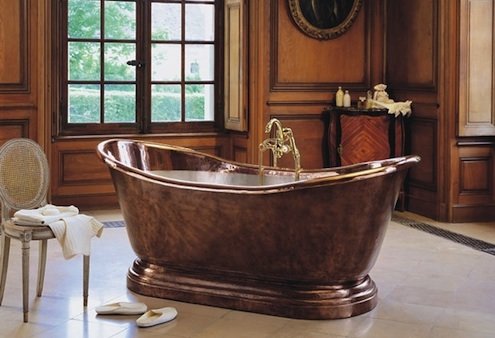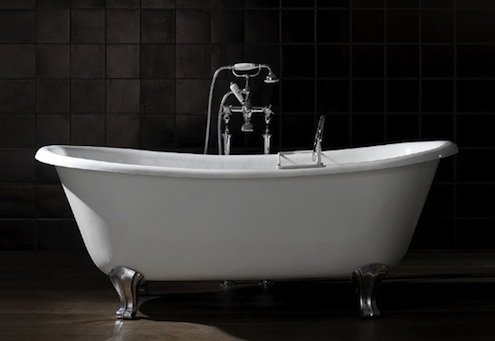We may earn revenue from the products available on this page and participate in affiliate programs. Learn More ›
To take the edge off the pressures of daily life, many Americans are cultivating ways to relax and de-stress in their own homes by turning their bathrooms into spa-like sanctuaries.
New bathroom technologies—from steam showers, body sprays, and hydro-massage shower heads to towel warmers, chromatherapy components, and radiant-heat floors—have emerged in recent years to soothe tired muscles, relax the body, and calm the mind.
Central to many of today’s spa-inspired baths are freestanding soaking tubs, which have replaced the Jacuzzis and sunken garden bathtubs that were ubiquitous in design a few years ago.
Related: Free-Standing Tubs—Soaking Up the Luxury
The Basics of Free-Standing Bathtubs
These old-style soaking tubs forego the noise and vigor of bubbling jets in favor of a deep, quiet soak. The tubs also come in a wide range of materials and finishes, such as wood, copper, and enamel, and often feature accents like old-fashioned claw feet or organic, modern shapes.
According to New York designer Kent Brasloff, vice president of programs for the New York chapter of the National Kitchen & Bath Association (NKBA), free-standing tubs have largely been a high-ticket item but are now appearing more and more in the middle market.
“For those with the additional space, they make a nice change by adding a sculptural element,” says Brasloff, who notes that these tubs are generally better in a non-urban environment due to space and weight restrictions. “This type of tub is a tricky fit in apartments, but in larger condos and single-family homes they can add a feeling of luxury and the sophistication of ‘spa,’” he says.

Free-Standing Bathtub Materials
Brasloff suggests choosing a tub made of a material suitable for your space.
CAST IRON
Cast iron tubs are extremely heavy, for example, while those made of resin and fiberglass can be light by comparison. “Cast iron, however, retains heat better than any other product on the market and is available in a wide range of colors—it is also among the best at resisting scratching, fading, and chipping,” Brasloff notes.
FIBERGLASS
“Fiberglass, on the other hand, is the least expensive option with regard to price and is very easy to install,” although fiberglass products have a “higher risk of scratching and fading, as well as cracking.”
ACRYLIC
Acrylic tends to crack and discolor over time but does provide a variety of shapes, sizes, and colors, pleasing to many tastes and wallet-friendly, Brasloff adds. “Wood and stone are both bold choices that make a distinctive style statement, yet both reflect top-of-the-market pricing and require a high level of maintenance to retain their beauty.”
SOLID SURFACE
Relatively new to the market are solid surface materials that retain heat well; come in an endless variety of shapes, sizes, and colors; and can be easily repaired. “Prices for these tend toward the high end,” says Brasloff. “And you can also expect fairly long lead times with this product.”
COPPER
Old-fashioned copper and brass tubs conduct heat at extremely high temperatures, are high-maintenance and extremely expensive, but they can offer either vintage or contemporary decorative impact and provide a stunning focal point.

